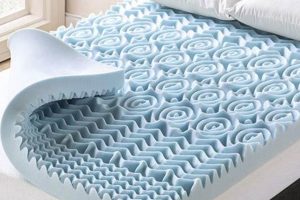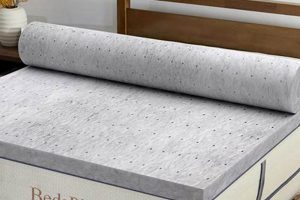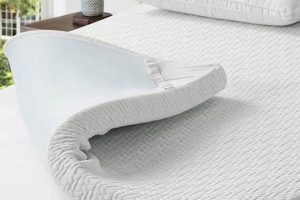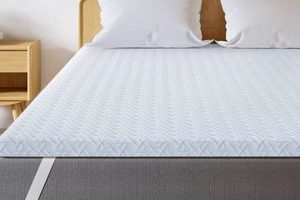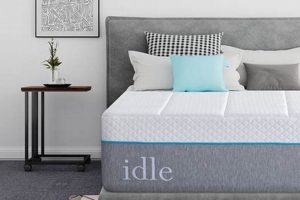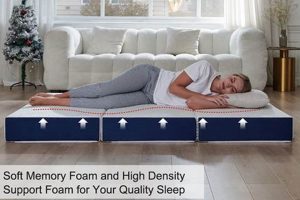A sleep surface enhancement with a substantial profile, this product offers a significant layer of cushioning atop a mattress. Designed to modify the feel of a sleeping platform, it provides additional support and comfort. For instance, a firm mattress can be made to feel softer with the addition of this type of overlay.
The advantages of using a product of this depth include improved pressure relief, particularly beneficial for individuals with joint pain or pressure sensitivity. The increased height can also make it easier to get in and out of bed. Historically, such additions were often employed to extend the lifespan of older, less comfortable mattresses or to adapt the sleeping surface to individual preferences without replacing the entire mattress.
The following discussion will explore the materials commonly used in these products, their construction methods, considerations for selecting the right option based on individual needs, and guidance on care and maintenance to ensure longevity.
Essential Considerations for a Substantial Mattress Overlay
The following guidelines offer crucial information for selecting and utilizing a thick mattress overlay to maximize comfort and longevity.
Tip 1: Material Selection is Paramount: Prioritize materials based on individual needs. Memory foam offers conforming support and pressure relief, while latex provides resilience and breathability. Consider potential allergies when choosing materials.
Tip 2: Assess Mattress Condition: Evaluate the existing mattress. A worn-out mattress with significant sagging will not be adequately corrected by simply adding an overlay. Address underlying support issues before investing in an additional layer.
Tip 3: Measure Mattress Depth Accurately: Accurate measurement is vital for proper sheet fit. Ensure existing sheets are deep enough to accommodate the increased height of the mattress and overlay; otherwise, purchasing new, appropriately sized sheets will be necessary.
Tip 4: Consider Heat Retention: Certain materials, notably memory foam, can retain heat. If overheating is a concern, opt for overlays with cooling technologies, such as gel infusions or open-cell structures, to promote airflow.
Tip 5: Factor in Body Weight and Sleeping Position: Body weight and preferred sleeping position influence the optimal firmness level. Heavier individuals may require denser materials for adequate support, while side sleepers may benefit from softer, more contouring overlays.
Tip 6: Evaluate Support Needs: While primarily designed for comfort, some overlays offer added support. If back pain is a concern, consider options with zoned support or firmer materials to promote spinal alignment.
Tip 7: Maintain Proper Hygiene: Regularly clean the overlay according to manufacturer instructions. Use a mattress protector to prevent stains and protect against allergens. Promptly address any spills to prevent permanent damage.
Proper selection and maintenance of a thick mattress overlay can significantly improve sleep quality and extend the lifespan of the underlying mattress. However, careful consideration of individual needs and existing mattress condition is essential for optimal results.
The subsequent sections will delve into specific overlay types, addressing common concerns and providing detailed care instructions.
1. Thickness and Support
Thickness directly influences the level of support a mattress overlay provides. A 4-inch profile offers significantly more cushioning and contouring compared to thinner alternatives. This increased mass allows for greater compression, distributing body weight more evenly across the sleep surface. The resulting reduction in pressure points is particularly beneficial for individuals experiencing joint pain or discomfort. The choice of material within the 4-inch dimension further determines the type of support. For example, dense memory foam provides conforming support, while resilient latex offers more buoyant support, each catering to distinct preferences.
The relationship between thickness and support is not linear. Beyond a certain point, increased thickness does not necessarily translate to proportionally greater support. Instead, the material’s density and firmness become more critical. A 4-inch overlay made of high-density foam will provide more support than one of the same thickness made of low-density material. A practical application is seen in individuals with higher body mass, who often benefit from the increased support provided by a 4-inch, high-density overlay, preventing the sensation of sinking too deeply into the mattress.
In summary, thickness contributes substantially to the support provided by a mattress overlay, but material composition and density are equally important. Selecting a 4-inch overlay requires careful consideration of individual needs and preferences. The practical significance lies in achieving optimal spinal alignment and pressure relief, ultimately leading to improved sleep quality and reduced physical discomfort. While a thicker overlay generally offers more potential for support, the specific material properties dictate the final outcome.
2. Material Composition
The material composition of a 4-inch mattress overlay is a determining factor in its performance characteristics and overall suitability for various sleep preferences and needs. The choice of material directly impacts properties such as pressure relief, temperature regulation, support, and durability. For instance, a 4-inch overlay constructed from memory foam will conform to the body’s contours, distributing weight and reducing pressure points. Conversely, a latex overlay of the same thickness provides a more resilient, buoyant feel, offering a different type of support. The effects are varied and noticeable to the end user, directly affecting sleep quality.
Diverse materials are used, each with distinct attributes. Polyurethane foam, often found in less expensive overlays, offers basic cushioning but may lack the longevity and pressure-relieving capabilities of memory foam or latex. Gel-infused memory foam attempts to mitigate the heat retention commonly associated with traditional memory foam. Wool and feather blends provide natural temperature regulation and softness but require specialized care and may not be suitable for individuals with allergies. The blend of materials, if any, also contributes to the final performance. A combination of high-density support foam with a top layer of gel-infused memory foam aims to provide both support and cooling comfort. The understanding of these material differences is therefore crucial for selecting an appropriate overlay based on individual priorities.
In summary, the selection of materials used in a 4-inch mattress overlay is not merely a matter of preference but a critical determinant of its functionality and suitability. Each material possesses unique characteristics that impact comfort, support, temperature regulation, and durability. Awareness of these properties allows for informed decision-making, ensuring that the chosen overlay effectively addresses individual needs and contributes to improved sleep quality. Ignoring this aspect can lead to discomfort, inadequate support, and premature product degradation.
3. Pressure Relief Properties
A substantial overlay significantly influences pressure distribution on the sleeping surface. The increased thickness inherent in a 4-inch mattress pad allows for greater compression and contouring, thereby reducing concentrated pressure points. This is particularly relevant for individuals experiencing discomfort in areas such as the shoulders, hips, and knees, where body weight is disproportionately focused. By distributing this weight more evenly, a substantial overlay mitigates stress on these pressure points, potentially alleviating pain and improving sleep quality. The specific material composition, such as memory foam or latex, further enhances this effect through conforming to the body’s unique shape.
The importance of pressure relief is underscored by its direct impact on circulation. Prolonged pressure on certain areas can restrict blood flow, leading to discomfort, numbness, and the need to shift positions during sleep. These disruptions can significantly impair sleep quality and contribute to daytime fatigue. A 4-inch mattress pad designed with effective pressure relief properties can minimize these disruptions, promoting uninterrupted sleep and restorative rest. For example, consider an individual recovering from surgery or managing chronic pain conditions; the ability of such an overlay to reduce pressure and promote circulation becomes a critical factor in comfort and healing. This practical significance extends to everyday comfort and general well-being.
In summary, the pressure relief properties of a 4-inch mattress pad represent a key component of its overall functionality and value. The ability to redistribute weight and reduce concentrated pressure points is not merely a matter of comfort but also a determinant of sleep quality, circulation, and potential pain management. While material composition plays a significant role, the substantial thickness of the overlay provides the foundation for achieving optimal pressure relief. The challenge lies in selecting a product that balances pressure relief with adequate support, based on individual needs and preferences.
4. Temperature Regulation
Temperature regulation within a sleep environment is a critical factor influencing sleep quality. The interaction between a substantial mattress overlay and body temperature must be carefully considered to optimize thermal comfort and prevent sleep disturbances.
- Material Breathability and Airflow
The inherent breathability of materials significantly impacts heat retention and dissipation. Denser materials, such as memory foam, tend to restrict airflow, potentially leading to increased body temperature and discomfort. Conversely, materials like latex or those incorporating open-cell structures promote greater airflow, facilitating heat dissipation and maintaining a cooler sleep surface. For example, a high-density memory foam overlay may be less suitable for individuals prone to night sweats, while a latex overlay with ventilation channels could offer improved thermal regulation.
- Heat Retention Properties
Different materials exhibit varying degrees of heat retention. Memory foam, known for its conforming properties, also tends to trap heat due to its dense structure. This can lead to a build-up of body heat during the night, potentially causing discomfort and restlessness. Gel infusions and other cooling technologies are often incorporated into memory foam overlays to mitigate this effect, attempting to improve heat dissipation. For instance, a gel-infused memory foam overlay aims to provide the pressure-relieving benefits of memory foam while minimizing heat retention. However, the effectiveness of these technologies can vary.
- Moisture Wicking Capabilities
The ability of a material to wick away moisture is another essential aspect of temperature regulation. Perspiration during sleep can contribute to discomfort and disrupt sleep. Materials with moisture-wicking properties, such as wool or specialized synthetic fabrics, can help to draw moisture away from the body, promoting a cooler and drier sleep environment. Consider an individual living in a humid climate; a 4-inch mattress pad with moisture-wicking properties could significantly improve sleep comfort by minimizing the effects of humidity and perspiration.
- Thickness and Insulation
While promoting airflow is crucial, a thicker overlay can also act as an insulator, buffering against temperature fluctuations in the surrounding environment. A 4-inch mattress pad, by its sheer volume, can provide a degree of insulation, helping to maintain a more stable temperature at the sleep surface. This can be particularly beneficial in environments with fluctuating temperatures or inadequate climate control. For example, during colder months, a thicker overlay can help to retain body heat, preventing the sensation of being cold while sleeping.
The interplay between these factors determines the overall temperature regulation characteristics of a 4-inch mattress pad. Selecting an overlay that effectively balances breathability, heat retention, moisture wicking, and insulation is crucial for achieving optimal thermal comfort and promoting restful sleep. The ideal choice depends on individual preferences, climate conditions, and any specific thermal sensitivities. Ignoring these considerations can lead to discomfort and sleep disturbances, negating the potential benefits of using a substantial mattress overlay.
5. Mattress Protection
A substantial mattress overlay, specifically a 4-inch mattress pad, inherently provides a degree of protection to the underlying mattress. This protective function arises from its physical presence as a barrier against direct contact with potential sources of damage. These sources include spills, stains, body fluids, dust mites, and general wear and tear. The pad acts as a sacrificial layer, absorbing impacts and contaminants that would otherwise directly affect the mattress. For example, accidental spills are more likely to be contained within the overlay, preventing them from penetrating and damaging the mattress core. This proactive approach preserves the mattress’s cleanliness, structural integrity, and overall lifespan.
The level of protection offered is further enhanced by the material composition and construction of the 4-inch mattress pad. Certain materials, such as waterproof or water-resistant fabrics, provide a greater barrier against liquid penetration. Additionally, features like zippered encasements or fitted skirts contribute to complete mattress coverage, preventing allergens and pests from reaching the underlying mattress. The practical implications are significant, particularly for individuals with allergies or sensitivities to dust mites. A fully encased mattress pad minimizes exposure to these allergens, contributing to improved respiratory health and sleep quality. Beyond allergy concerns, this proactive protection safeguards against warranty voidance, as many mattress warranties are invalidated by stains or unsanitary conditions.
In summary, the mattress protection afforded by a 4-inch mattress pad is an integral aspect of its overall value proposition. While primarily intended for comfort enhancement, the pad simultaneously serves as a barrier against potential damage, extending the lifespan and preserving the condition of the underlying mattress. The effectiveness of this protection is contingent upon the material composition, construction, and maintenance of the pad. Understanding this protective function enables informed decisions, ensuring that the selected overlay not only improves sleep quality but also safeguards the investment in the mattress itself. The added protection can prevent costly replacements and contribute to a healthier sleep environment.
6. Proper Sheet Fit
The addition of a 4-inch mattress pad to a standard mattress significantly alters its overall height, necessitating careful consideration of sheet dimensions to ensure proper fit and avoid discomfort or functional issues. Ill-fitting sheets can compromise the benefits of the pad itself, creating an unsatisfactory sleep experience.
- Pocket Depth Requirements
Standard sheet sets are typically designed for mattresses of average thickness. The introduction of a 4-inch pad increases the overall mattress height, requiring sheets with deeper pockets to accommodate the added dimension. Failure to use sheets with adequate pocket depth can result in the sheets slipping off the mattress corners, causing nightly disturbances and premature wear on both the sheets and the pad. For example, a mattress that was previously 12 inches thick will now measure 16 inches, demanding “deep pocket” sheets designed for this increased height.
- Material Stretch and Elasticity
While pocket depth is critical, the material’s stretch and elasticity also play a role in achieving a proper fit. Sheets with inherent stretch can better conform to the contours of the mattress and pad, reducing the likelihood of slippage. Elasticized edges further enhance this effect by providing a secure grip on the mattress. However, excessive stretching can compromise the fabric’s integrity over time, leading to premature wear. Consequently, the material’s inherent properties must be balanced with appropriate dimensions to ensure both a secure and durable fit.
- Sheet Size Compatibility
While deep pocket sheets address the height issue, the overall sheet size (Twin, Full, Queen, King, etc.) must still correspond to the dimensions of the mattress. Using sheets that are too small, even with deep pockets, will result in insufficient coverage and an inability to properly secure the corners. Conversely, sheets that are too large can create excess fabric that bunches and wrinkles, leading to discomfort and potential safety hazards. Confirming that both the overall sheet size and the pocket depth are appropriate for the combined mattress and pad dimensions is essential for a comfortable and functional sleep setup.
- Impact on Pad Performance
An improperly fitted sheet can negate some of the performance benefits of the 4-inch mattress pad. Sheets that are stretched too tightly across the pad can compress the material, reducing its ability to conform to the body and alleviate pressure points. Additionally, loose or wrinkled sheets can create uneven surfaces that diminish the overall comfort and support provided by the pad. Proper sheet fit ensures that the pad functions as intended, providing optimal comfort and pressure relief throughout the night. Therefore, proper sheet fit can lead to proper performance of the mattress pad.
The selection of appropriately sized and fitted sheets is an indispensable element of maximizing the benefits of a 4-inch mattress pad. Overlooking this seemingly minor detail can compromise comfort, reduce pad effectiveness, and potentially damage both the sheets and the pad itself. Therefore, careful consideration of sheet dimensions, material properties, and overall compatibility is essential for a satisfying sleep experience.
Frequently Asked Questions
The following addresses common inquiries regarding the selection, utilization, and maintenance of substantial mattress overlays, providing clarity on their features and benefits.
Question 1: Does a thicker overlay negate the need for a new mattress?
A substantial overlay can enhance comfort and extend the lifespan of a mattress in reasonable condition. However, it will not remedy significant structural issues such as broken springs or severe sagging. Addressing underlying support deficiencies is necessary for optimal sleep quality.
Question 2: How does the density of the foam affect the performance?
Density is a primary determinant of support and durability. Higher density foams offer greater resistance to compression and provide more consistent support over time. Lower density foams may offer initial softness but are prone to premature breakdown.
Question 3: Is a 4-inch overlay suitable for all body types?
A substantial overlay generally accommodates a wide range of body types. However, individuals with significantly higher body mass may require a firmer overlay with enhanced support to prevent excessive sinking and maintain spinal alignment.
Question 4: How does one properly clean and maintain such a thick overlay?
Cleaning protocols vary depending on the material. Generally, spot cleaning with mild detergent is recommended. Avoid saturating the material. Professional cleaning may be necessary for extensive stains or odors. Using a mattress protector can significantly reduce the need for frequent cleaning.
Question 5: Will this overlay fit under standard fitted sheets?
The added height necessitates deep-pocket sheets specifically designed to accommodate thicker mattresses. Standard sheets will likely not fit properly and may slip off the corners, compromising comfort and functionality.
Question 6: How does the material impact temperature regulation?
Certain materials, such as memory foam, tend to retain heat. Others, like latex or gel-infused foams, offer better airflow and heat dissipation. Consider individual thermal preferences and potential for overheating when selecting materials.
In conclusion, selecting a substantial mattress overlay requires careful consideration of individual needs and preferences. The provided information addresses common concerns and facilitates informed decision-making.
The following sections will delve into specific overlay types, addressing common concerns and providing detailed care instructions.
Conclusion
The preceding analysis has illuminated the multifaceted considerations surrounding the acquisition and utilization of a 4 inch mattress pad. From material composition and support characteristics to pressure relief, temperature regulation, mattress protection, and proper sheet fit, each element contributes to the overall efficacy and suitability of the product. A comprehensive understanding of these factors is paramount for informed decision-making.
The selection of a 4 inch mattress pad represents a significant investment in sleep quality and mattress longevity. Prioritizing individual needs and carefully evaluating the available options will yield the greatest return on that investment. Further research and consultation with sleep professionals are encouraged to ensure optimal alignment with personal requirements. The enduring significance of restful sleep underscores the importance of making well-informed choices regarding sleep surface enhancements.


